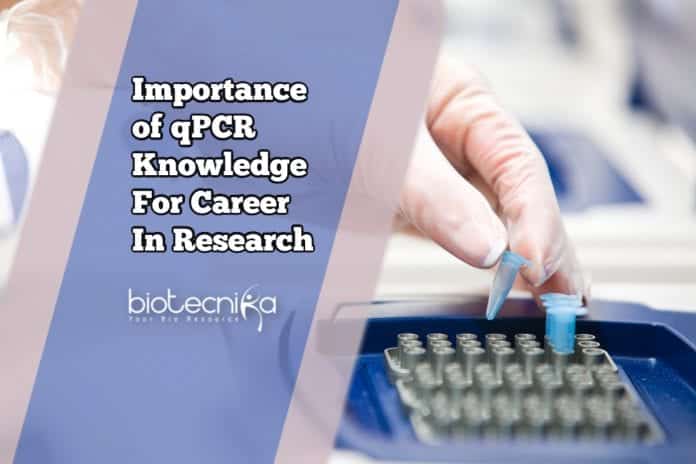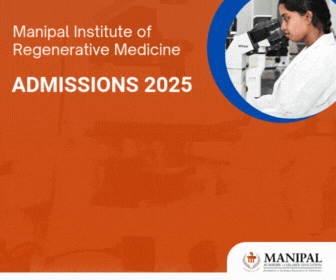Importance of qPCR in Research -The Inevitable Technique In Research
Quantitative PCR (qPCR) is a varied and broadly appropriate laboratory technique facilitating the detection and quantification of genetic material, generally used for both diagnostic and basic research. qPCR has been used for wide-ranging applications which include
- Gene Expression (mRNA) Analysis
- MicroRNA and Non-Coding RNA analysis
- Genetic Variation
- Mutation Detection
- SNP Analysis
- Genotyping/Allelic Discrimination
- Progression of drug discovery
- Characterize and quantify nucleic acids
Universally, in RT-qPCR, RNA transcripts are quantified by reverse transcribing them into cDNA, followed by qPCR. In conventional PCR, DNA is amplified by three recurring steps of denaturation, annealing, and elongation. In qPCR, fluorescent labeling allows the collection of data as PCR develops. This technique has numerous advantages owing to an array of processes and chemistries available.
Table of Contents
PCR Technique Online Certification Program
There are mainly two types of qPCR; Dye-based qPCR and Probe-based qPCR. In dye-based qPCR, fluorescent labeling permits the quantification of the amplified DNA by retaining the usage of a dsDNA binding dye, and fluorescence is calculated in each cycle. The fluorescence signal raises proportionately to the volume of DNA copies , and thus the DNA is computed in “real-time.”
In probe-based qPCR, several targets can be identified concurrently in each sample, but this necessitates optimization and design of a target-specific probe(s) utilized in add-on to primers. Fluorescence signal from a probe-based qPCR reaction is relational to the quantity of the probe-target sequence available in the sample. Since probe-based qPCR is extra specialized than dye-based qPCR, because of this reason, it is every so often the technology applied in qPCR diagnostic assays.
Arenas of qPCR applications are exceptionally distinct as follows:
- Molecular diagnostics
- Drug discovery
- Pre-clinical and clinical studies
- Pharmacology
- Toxicology
- Veterinary diagnostics
- Phytopathology
- Food quality.
qPCR is also the preferred platform for high throughput screening, where a large number of samples are screened for hundreds of expression markers. Let’s look at the importance of qPCR in research in detail.
REGISTER FOR MOLECULAR Biology Techniques Self Learning – Certification Course
Molecular diagnostics
qPCR has transformed molecular diagnostics through its ease of use, enhanced sensitivity along with specificity, and minimal turnaround time. qPCR based assays extend a distinctive benefit than the standard serological diagnostic methodologies. The capability to detect infectious diseases has gained from the accessibility of US FDA approved and CE-marked qPCR based diagnostic kits from overseas companies. The superior kits are standardized with the WHO and NIBSC standards. The prerequisite for confirming quality-assurance measures for qPCR-based assays.
qPCR has precise quantification of nucleic acids and aids to develop the sensitivity of the assay. Therefore, the field of molecular diagnostics substituting the conventional serological approach. Furthermore, it is crucial to comprehend the complexities of the system and give a precise diagnosis. qPCR has been adapted to detect fungal disease (Aspergillus and Candida), RNA viruses (HIV and hepatitis C), and the analysis of RNA transcripts associated with some cancers.
Drug discovery
Quantification of DNA or mRNA copies with the qPCR have renovated the drug development. This renovation is propelled by the evidence of measurements that provide a better insight into the molecular dimension of disease, efficacy, and toxicity for new drugs. This information is turned down into accurate genomic biomarkers of drug development processes. Some of the studies which illustrated such as translation of P450 enzyme activity measurements to gene expression in drug metabolism studies, quantification of cytokine along with chemokine genomic expression levels as clinical markers, and the identification of genomic biomarkers of nephrotoxicity, etc. In-Depth knowledge of factors concerning qPCR quantification can streamline their execution of high‐throughput platforms for these studies.
Pre-clinical and clinical studies
qPCR assays are used with the purpose of discovering suitable biomarkers for pre-clinical and early clinical studies. In biomarker research, the analysis of mRNA expression profiles in the perspective of convoluted biological pathways is of great concern. It embodies a usual preliminary step in the discovery of suitable biomarkers. The qPCR technology is recognized to be exceedingly detailed and delicate than the microarray technology, but the limitation is that a single gene can be evaluated at a time. Therefore, the objective of the qPCR was to offer high throughput processing of genes for efficient expression profiling.
Toxicology
qPCR techniques have extensively used in toxicology, prominent to the establishment of a new field molecular toxicology. The goal line of molecular toxicology is to identify and examine the modifications generated by xenobiotics at the molecular level. The research extent of molecular toxicology comprises genomic DNA mutation detection, mRNA expression differences, and genotype studies, which indicate the sensitivity of individuals. qPCR procedures allocate accurate analysis of xenobiotics effects on cells and tissues by assessing the activation level of phase I and II genes coding enzymes, or by examining the activity of other elements in the transcriptome. Studies of individual cells or tissue sensitivity depending on the analysis of mutation or gene polymorphism incidence are relevant, and this increases the importance of qPCR in research.
PCR Technique Online Certification Program
Clinical diagnostics
qPCR has been proven to be enormously effective for quantification of viruses and bacteria, and a lesser extent for fungi, parasites, and protozoans. Besides, for bacterial infection detection, the PCR technique a great leap forward of efficient antibiotic treatment. In Fact, due to prompt and precise real-time detection, the infection level of the patient is very more evident for the clinician, which facilitates the timely specific application of antibiotic treatment. Moreover, quantification of gene transfer vectors used for gene therapy can also be done. Two critical parameters that need to be analyzed in gene therapy are the expression level of the therapeutic gene and the distribution of the drug in different organs. Concerning clinical oncology, main endeavors have been commenced to augment qPCR techniques for minimal residual disease, single nucleotide polymorphisms, and chromosomal translocations detection.
qPCR has considerably streamlined the quantification of DNA and RNA. This has a huge effect in the sphere of molecular research and clinical diagnostics because immense data can be attained within a short span of research time. The real-time thermal cyclers and reagents utilized in the technique are cost-effective, and the advancement of high throughput robotic systems for reaction preparation made not only a rapid increase in use but also become the gold standard for nucleic acid detection.
Veterinary diagnostics
qPCR has been magnificently employed as a front-line apparatus in the diagnostic algorithm for certain veterinary viral pathogens such as Avian Influenza, foot-and-mouth disease, bluetongue virus, as well as rabies and Newcastle disease virus. A quick communicable type of these agents imposes real-time detection and diagnosis in presumed sick animals to let control procedures implementation.
Phytopathology
Rapid-cycle qPCR techniques innovate the identification of plant pathogens and the diagnosis of disease. When the genomics era evolves, the availability of huge DNA sequence data allows us to design specific primers and fluorescent probe against the unique regions of a pathogen’s genome to amplify them. Rapid qPCR diagnosis helps us to device applicable control or eradication measures rapidly and perfectly than the traditional methods.
Food quality
One of the qPCR applications is the most promising innovations in food safety and quality supplying fast, consistent, and quantitative findings. Nowadays, qPCR has become an invaluable replacement to traditional detection methods, especially in the agricultural and food industries.
PCR Technique Online Certification Program
The benefits of qPCR consist of speed, an outstanding detection limit, selectivity, specificity, sensitivity, and the possibility for automation. The importance of qPCR in research is non-trivial. Even Though the development of this technique appears to be inevitable, certain shortcomings are still to be considered, such as expense for establishing and performing qPCR experiments is yet high-level for small laboratories and few laboratories in developing countries. Also, the quality of the PCR experiments is hugely affected by sample preparation.
Both theoretical and practical knowledge in qPCR is very important for those who are looking for a career in research as the technique is used in almost every research laboratories on a daily basis. Whether you are looking for a research job in private and government firms or you are looking for a doctoral position, there is a high possibility that you will encounter questions about qPCR in the interview and that the recruiters will look for your experience in the same.
Author : N.Elamathi
Importance of qPCR in research








































Sir m research m work krna chata hu … Nasa m work krna mere liye ak life ka big dream h only my single gole for nasa .. Im in now bsc plzz sir tell us me muje ak moka do plzz sir space since or research m jarur .. Golden work krunga